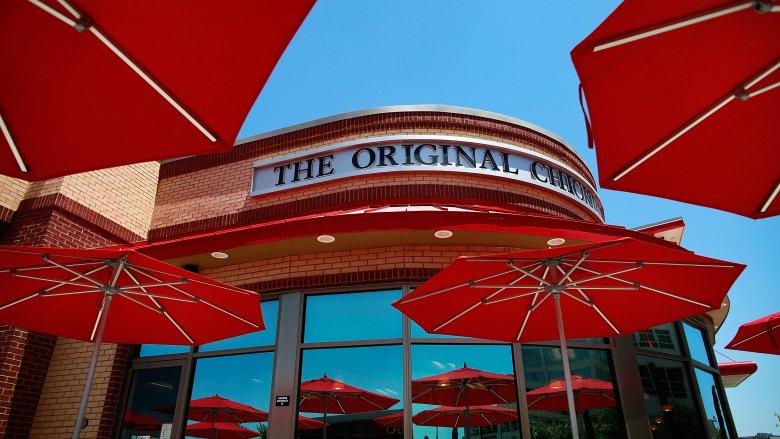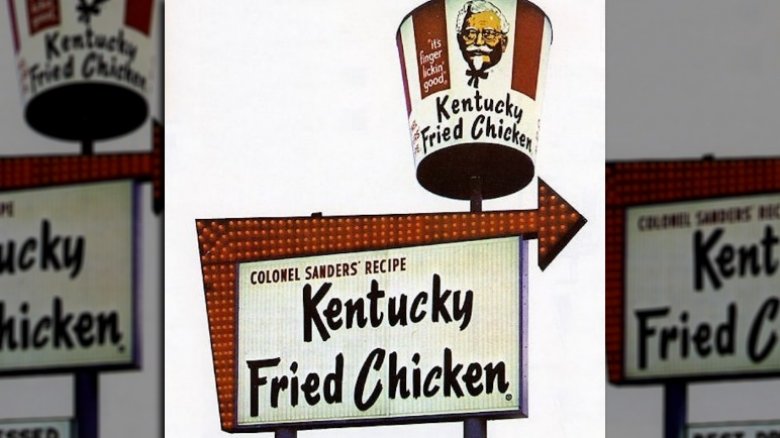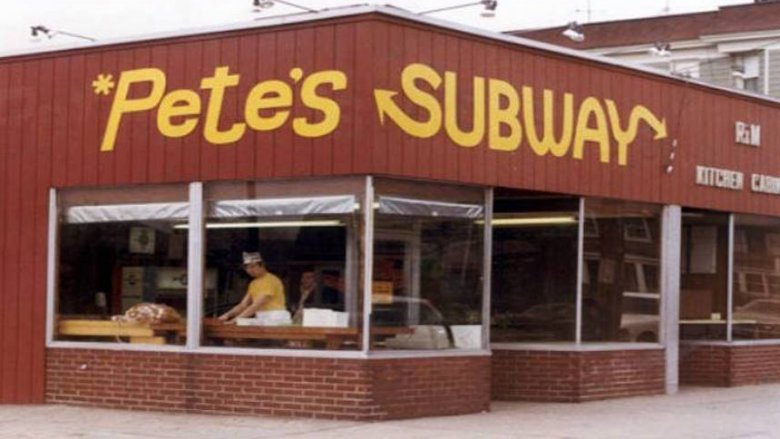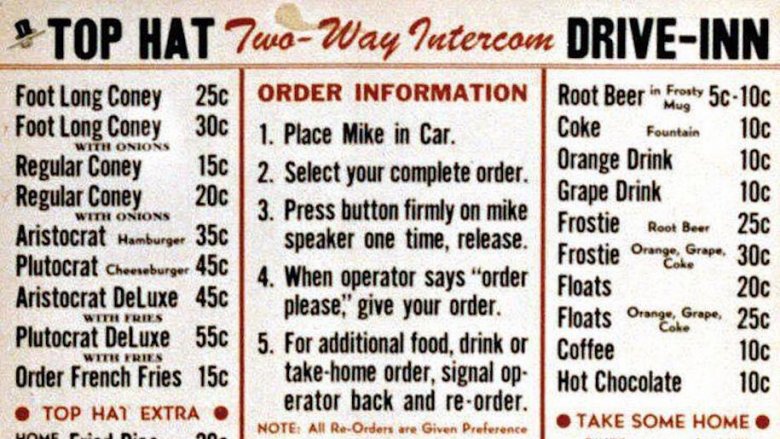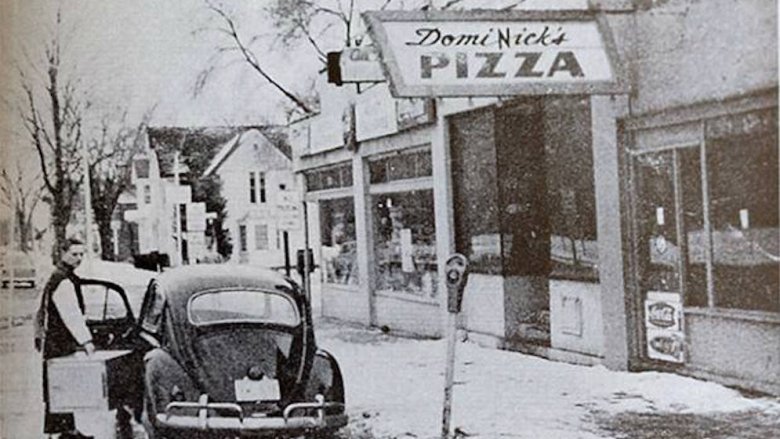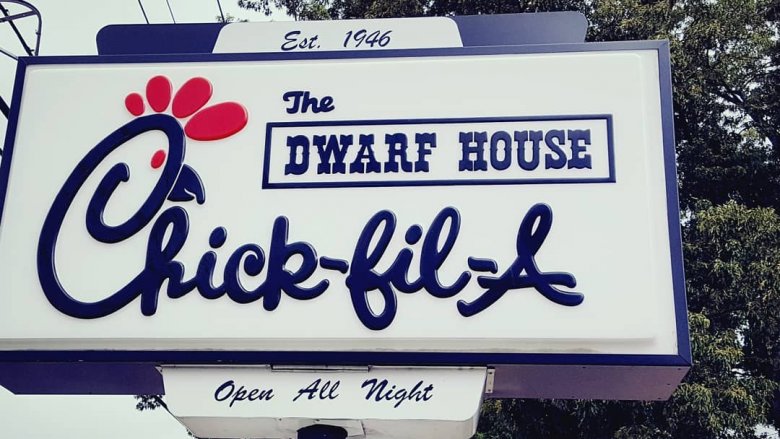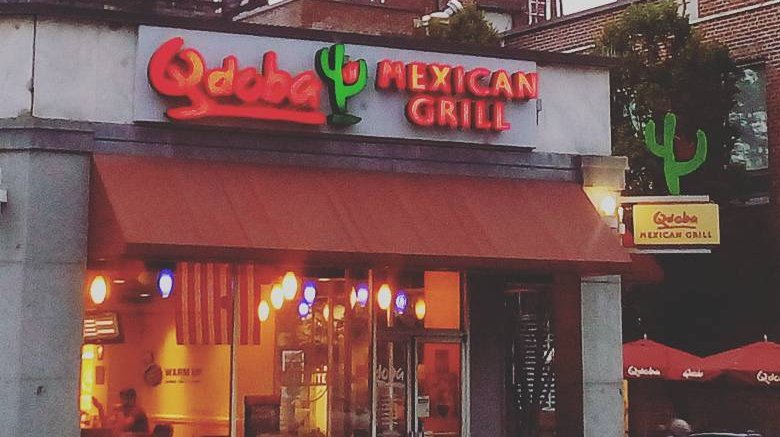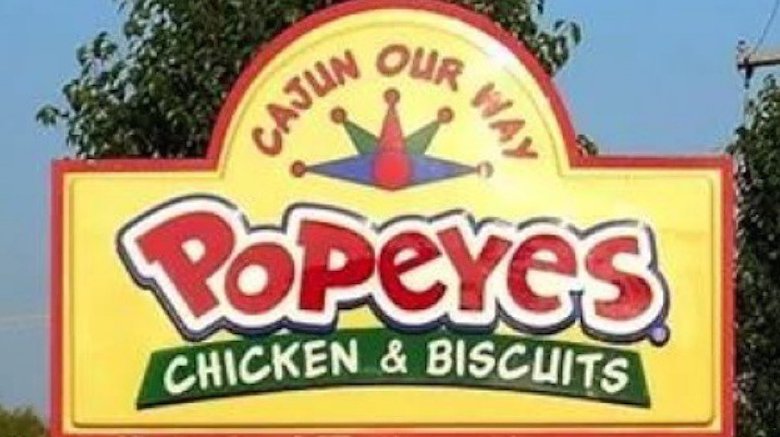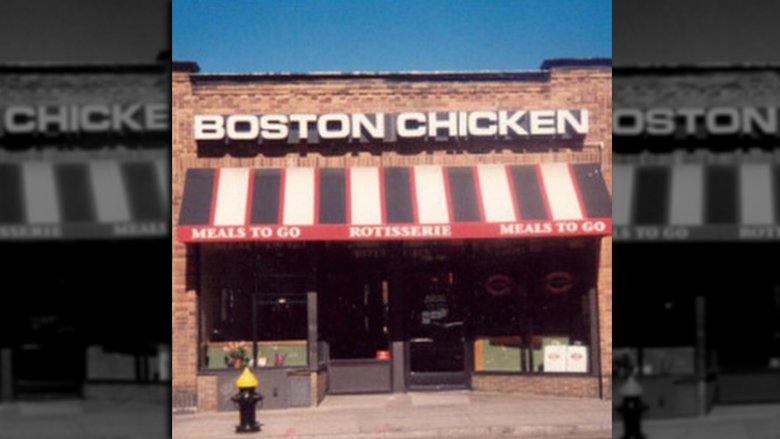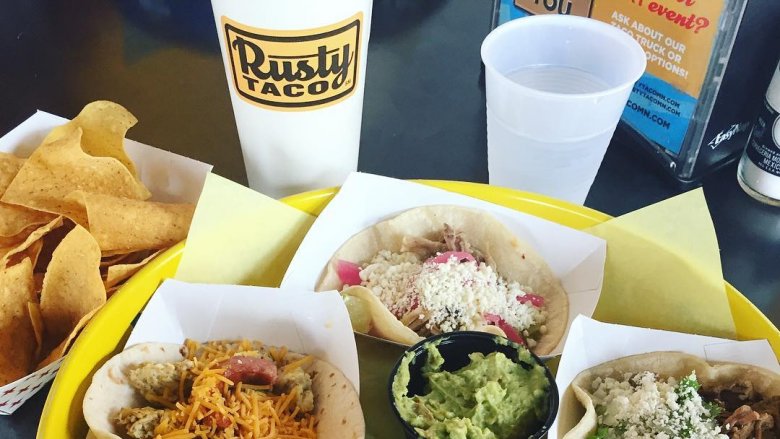Restaurants You Didn't Know Changed Their Name
IHOP confused thousands of people when it suddenly changed a single letter in its name: A new burger menu prompted the acronym, IHOb, and attempted to shift the restaurant's focus away from the pancake dishes everyone had grown to associate with the company. But while their campaign spread faster as a result of social media, they are far from the first restaurant to rebrand.
Several fast food or quick-service dining establishments have been called something else, at some point or other. Many times, the name change is subtle, something that flies under the radar, like the dropping of a word. Other times, it's called something completely different, and is accompanied by a whole new "look and feel" that makes the restaurant feel brand new. New menu items, getting acquired by larger companies, or the passing of a torch to new owners, are all reasons why you might see an old name today, and a new one tomorrow. Here are just a few restaurants you probably didn't know were once called something else.
KFC
Now an acronym, this fast food, fried chicken chain was once called Kentucky Fried Chicken. It was the brainchild of Colonel Harland Sanders, who not only developed the franchise, but became its spokesperson and mascot (an image that still remains today).
But interestingly enough, the original name wasn't something Sanders came up with: it was coined by Don Anderson, a man hired to paint a sign at the Harman Cafe in Salt Lake City, Utah, advertising Sanders' fried chicken. He thought Kentucky Fried Chicken sounded like an exotic version of the classic comfort food. The name stayed until 1991, when the company low-key announced it would be changing to KFC.
It wasn't very clear to customers however, who began speculating about the name change. Many thought the name was truncated because KFC was using mutant chicken, and therefore couldn't "legally" use the word chicken in their branding. In 2016, a post on the KFC website addressed the rumors — it turns out, the name was changed because KFC was simply easier to say, and was already being used by a number of people. "We wanted to let our customers know that we had more for them to enjoy than just fried chicken," the post continues. "We've always used 100% real chicken."
Subway
Many can agree that Subway is a clever name for a shop that sells submarine sandwiches, but it wasn't always called that. Originally, the sandwich chain was named after Dr. Peter Buck, a nuclear physicist from Connecticut. He invested $1,000 into an idea that Fred DeLuca, a promising young entrepreneur from Brooklyn had, to open up a sandwich shop. Pete's Super Submarine's of Bridgeport, Connecticut opened its doors in 1965, serving up sammies that cost less than 70 cents, according the Subway website.
While naming a sandwich shop after a nuclear physicist is cool, Buck and DeLuca decided Pete's Super Submarines wasn't cutting the mustard. Pete's Subway first appeared on signs in 1968, and was changed again to just Subway in 1974 (according to the Washington Post, "Pete's Submarines" sounded too much like "Pizza Marines"). This coincided with the first franchised Subway shop, which eventually gave way to over 44,000 franchises currently in operation today. Not having his name above the restaurant door didn't seem to bother Buck very much; his initial investment clearly paid for itself, as the company was valued at about $7.1 billion dollars in 2017.
Sonic Drive-In
For years, Sonic Drive-In was a regional dining establishment that used cheeky commercials to torture those who lived too far to experience treats like Sonic Blasts, and chili cheese tots. Now, with over 3,500 Sonic restaurants in 44 states, it's a little easier to have your burgers, shakes, hot dogs and fries delivered to your car. Back in 1953 however, customers knew the drive-in restaurant by a much different name: Top Hat opened in Shawnee, Oklahoma, where it sold root beer and snacks to hungry customers. It was conceived by Troy Smith, who left the trucking business to open a number of dining establishments.
In an era where drive-in restaurants were all the rage, Top Hat stood out because it was innovative. According to their website, Top Hat was the first drive-in to utilize curbside speakers, letting customers place their orders without ever leaving their cars. Smith kept the roller skating carhops even after the trend died down, which helped meals get delivered to guests even quicker. "Service at the Speed of Sound" became their slogan, and in 1959, the name was officially changed to Sonic.
Domino's
Pizza is always associated with New York, but one of the most widely-recognized pizza delivery companies actually originated in the Midwest. The year was 1960, and for less than the cost of an iPhone X ($500, to be precise), brothers James and Tom Monaghan became the proud owners of a pizza shop in Ypsilanti, Michigan. It was originally owned by Dominick DiVarti, and lived under the name, DomiNick's. DomiNick's pizza was popular in the Ann Arbor part of the state, and delivered pies in a Volkswagon Beetle. When it came time to expand into more stores and locations, Tom Monaghan was faced with a problem: the original owner didn't want his name on just any pizza place. In 1965, through the suggestion of a delivery employee, Domino's was born.
The recognizable logo is a tribute to the early success of the company: shaped like a domino game piece, the three dots represent the three original locations, DomiNick's included.
Chick-fil-A
Fried chicken on a bun has a lot to live up to, thanks to S. Truett Cathy's revolutionary fast food chicken sandwich. By using a pressure-fryer, he was able to create a plump, juicy fillet of chicken cooked to perfection. Add two buttered buns and a few pickles, and you've got a sandwich many have tried to recreate for themselves, but fail to deliver on.
Standalone Chick-fil-A locations are now found across the US, but it all started back in Cathy's original restaurant, the Dwarf House. Cathy opened up the first location in Hapeville, Georgia, in 1946, and its main purpose was to sell diner-style food, with a Southern touch. The main focus was also on beef dishes, not chicken. But once Cathy started serving up his original family recipe for chicken sandwiches, customers couldn't get enough.
Chick-fil-A became a trademarked name for the product Cathy was selling; Dwarf House-Chick-fil-A locations sprouted up across the rest of Georgia and the surrounding areas. According to the company's website, the first official Chick-fil-A opened in a shopping center in in Atlanta in 1967. The original Dwarf House is still open today, and still serves Chick-fil-A sandwiches, as well as other items.
Qdoba Mexican Eats
Some restaurants rebrand so often, it's hard for customers to keep up. That's basically what happened to Qdoba Mexican Eats; the company's name changed over three times since its founding, back in 1995. These changes mostly occurred based on lawsuits from other restaurants with similar-sounding names. The company finally settled on Qdoba in 1999, after having to deal with the issues that came along with Zuma Fresh Mexican Grill, and Z-Teca Mexican Grill.
In 2015, the restaurant changed its name yet again, from Qdoba Mexican Grill, to Qdoba Mexican Eats. The name change came about after the company did some research into what their customers seemed interested in. "Mexican Grill has become a moniker many brands are using, but it doesn't have much meaning with consumers," David Craven, vice president of brand marketing at Qdoba, stated in an article on QSR. Switching to "Eats" allowed Qdoba to represent all of the offerings it had, not just the grilled ones.
Popeyes Louisiana Kitchen
Originally, Popeyes fell under the name, Chicken On The Run. According to the company's website, it was a small shop that opened in Louisiana, in 1972, and was run by Alvin C. Copeland Sr. In 1976, the restaurant rebranded and called itself Popeyes. Copeland developed a unique take on traditional Southern fried chicken: by adding extra spice, which he dubbed "New Orleans-style," he was able to create a fried chicken empire that could compete with other fast food joints.
According to Kristin Hunt's research for an article on Thrillist, Popeyes went through several name changes. Popeyes Mighty Good Fried Chicken, Popeyes Famous Fried Chicken, and Popeyes Chicken & Biscuits, were all used previously. Unfortunately, sales began to decline when the 2008 recession hit, and the company decided to rebrand again. Popeyes Louisiana Kitchen has been the name ever since, and may be its good luck charm: profits were high in 2017, meaning the craving for chicken and biscuits is still going strong.
Boston Market
Boston Market opened its first location in 1985, in Newton, Massachusetts, a suburb just 20 minutes outside of the state capital. Back then however, it was known as Boston Chicken. The idea was simple: offer familiar home cooking, complete with traditional sides like corn bread, mashed potatoes, and sautéed vegetables, to folks whose only other options were grocery stores specializing in gourmet items. The concept proved to be popular: according to The Balance, "by the end of 1992, there were 217 stores throughout the U.S., making $154 million in annual sales."
As the company grew, so did the store's menu. Soon, Boston Chicken began to sell turkey, meatloaf, and other homestyle dishes. The company rebranded in 1995 under the name Boston Market, to better reflect its offerings. The name hasn't changed in over 20 years, but during Super Bowl LII, a few locations in and around Philadelphia switched things up a bit: Boston Market became "Philly Market," in honor of the Philadelphia Eagles playing against the New England Patriots. It was a temporary and hilarious move which boosted city pride during the Big Game, and carried over even after the Eagles won.
R Taco
Restaurants that are named after their founders have a legacy all their own, which is often steeped in local history. Going national, however, sometimes requires a name change so that it feels more like an approachable product, and less like an exclusive location. That's what happened to R Taco, after it was purchased by Buffalo Wild Wings Inc. in 2015. Originally called Rusty Taco, the chain had been named after Rusty Fenton, the restaurant's founder. Buffalo Wild Wings changed the name however, because they wanted to ensure that what they were serving would resonate with people across the country, not just with those who knew Fenton personally.
Fenton opened his first restaurant in 2010 in Dallas, Texas. Unfortunately, Fenton wouldn't get to see his Mexican street-style taco legacy flourish; he passed away in 2013 from cancer, less than two years before his business was acquired. Buffalo Wild Wings has big plans for R Taco however; with 26 locations at the time of this writing, the restaurant plans on expanding nationwide to ensure what Fenton started grows bigger and better than ever.
